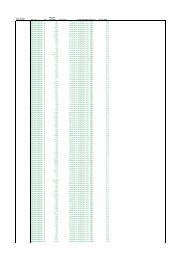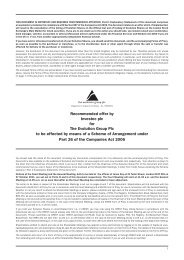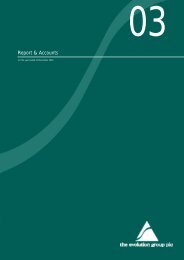Annual Report for the year ended 31 December 2008
Annual Report for the year ended 31 December 2008
Annual Report for the year ended 31 December 2008
Create successful ePaper yourself
Turn your PDF publications into a flip-book with our unique Google optimized e-Paper software.
1. aCCoUntinG PoliCies (CONTINuED)<br />
Standards, amendments and interpretations to existing standards that are<br />
not yet effective and have not been early adopted by <strong>the</strong> Group. The following<br />
interpretations and amendments to existing standards have been published<br />
and are mandatory <strong>for</strong> <strong>the</strong> Group’s accounting periods beginning on or after<br />
1 January 2009 or later periods, but <strong>the</strong> Group has not early adopted <strong>the</strong>m:<br />
• iFrs 8, ‘operating segments’ is required to be adopted <strong>for</strong> <strong>the</strong> Group <strong>for</strong><br />
<strong>the</strong> financial <strong>year</strong> ending <strong>31</strong> <strong>December</strong> 2009. The standard requires a<br />
‘management approach’ under which segmental in<strong>for</strong>mation is presented<br />
using <strong>the</strong> same method as that adopted <strong>for</strong> internal reporting purposes.<br />
This is not expected to have a significant impact on <strong>the</strong> Group;<br />
• iAs 23 (amendment), ‘Borrowing costs’ is required to be adopted <strong>for</strong> <strong>the</strong><br />
Group <strong>for</strong> <strong>the</strong> financial <strong>year</strong> ending <strong>31</strong> <strong>December</strong> 2009. The amendment<br />
requires borrowing costs directly attributable to <strong>the</strong> acquisition,<br />
construction or production of a qualifying asset to be capitalised. The<br />
option of immediately expensing those borrowing costs will be removed.<br />
This is not expected to have a significant impact on <strong>the</strong> Group;<br />
• iAs 1 (revised), ‘presentation of financial statements’ is required to be<br />
adopted <strong>for</strong> <strong>the</strong> Group <strong>for</strong> <strong>the</strong> financial <strong>year</strong> ending <strong>31</strong> <strong>December</strong> 2009.<br />
The revised standard requires comparative in<strong>for</strong>mation to be reclassified<br />
or restated, and a restated Balance sheet as at <strong>the</strong> beginning comparative<br />
period in addition to <strong>the</strong> current requirement to present Balance sheets<br />
at <strong>the</strong> end of <strong>the</strong> current period and comparative period to be shown.<br />
This is not expected to have a significant impact on <strong>the</strong> Group;<br />
• iFrs 2 (amendment), ‘share-based payment’ is required to be adopted <strong>for</strong><br />
<strong>the</strong> Group <strong>for</strong> <strong>the</strong> financial <strong>year</strong> ending <strong>31</strong> <strong>December</strong> 2009. This amendment<br />
clarifies that vesting conditions are service conditions and per<strong>for</strong>mance<br />
conditions only. o<strong>the</strong>r features of share based payments are not vesting<br />
conditions. This is not expected to have a significant impact on <strong>the</strong> Group;<br />
• iAs 32 (amendment), ‘Financial instruments presentation’ is required to<br />
be adopted <strong>for</strong> <strong>the</strong> Group <strong>for</strong> <strong>the</strong> financial <strong>year</strong> ending <strong>31</strong> <strong>December</strong><br />
2009. This amendment clarifies <strong>the</strong> classification of puttable financial<br />
instruments and obligations arising on liquidation. This is not expected to<br />
have a significant impact on <strong>the</strong> Group;<br />
• iAs 27 (revised), ‘consolidated and separate financial statements’ is required<br />
to be adopted <strong>for</strong> <strong>the</strong> Group <strong>for</strong> <strong>the</strong> financial <strong>year</strong> ending <strong>31</strong> <strong>December</strong> 2010.<br />
The revised standard requires <strong>the</strong> effects of non-controlling interests to be<br />
recorded in equity while no change in control will no longer result in gains<br />
or losses in goodwill. The Group is assessing <strong>the</strong> implications of this change;<br />
• iFrs 3 (revised), ‘Business combinations’ is required to be adopted <strong>for</strong><br />
<strong>the</strong> Group <strong>for</strong> <strong>the</strong> financial <strong>year</strong> ending <strong>31</strong> <strong>December</strong> 2010. The revised<br />
standard results in changes to <strong>the</strong> acquisition method of business<br />
combinations. The Group expects that this revision will impact <strong>the</strong><br />
accounts <strong>for</strong> business combinations in <strong>the</strong> financial <strong>year</strong> <strong>ended</strong> 2010;<br />
• iFrs 5 (amendment), ‘non-current assets held-<strong>for</strong>-sale and discontinued<br />
operations’ is required to be adopted <strong>for</strong> <strong>the</strong> Group <strong>for</strong> <strong>the</strong> financial <strong>year</strong><br />
ending <strong>31</strong> <strong>December</strong> 2010. The amendment clarifies that all of a subsidiary’s<br />
assets and liabilities as held-<strong>for</strong>-sale if a partial disposal will result in loss<br />
of control. This is not expected to have a significant impact on <strong>the</strong> Group;<br />
notes to tHe FinanCial statements CONTINuED<br />
FOR THE YEAR ENDED <strong>31</strong> DECEMBER <strong>2008</strong><br />
50 The evoluTion Group plc AnnuAl reporT & AccounTs <strong>2008</strong><br />
• iAs 36 (amendment), ‘impairment of assets’ is required to be adopted <strong>for</strong><br />
<strong>the</strong> Group <strong>for</strong> <strong>the</strong> financial <strong>year</strong> ending <strong>31</strong> <strong>December</strong> 2009. The amendment<br />
requires fair value less costs to sell is calculated on <strong>the</strong> basis of discounted<br />
cash flows. This is not expected to have a significant impact on <strong>the</strong> Group;<br />
• iAs 38 (amendment), ‘intangible assets’ is required to be adopted <strong>for</strong> <strong>the</strong><br />
Group <strong>for</strong> <strong>the</strong> financial <strong>year</strong> ending <strong>31</strong> <strong>December</strong> 2009. The amendment<br />
defines a prepayment as being recognised only if payment has been<br />
made in advance of receiving <strong>the</strong> right to goods or receipt of services.<br />
The Group is assessing <strong>the</strong> implications of this change; and<br />
• iAs 39 (amendment), ‘Financial instruments: recognition and measurement’<br />
is required to be adopted <strong>for</strong> <strong>the</strong> Group <strong>for</strong> <strong>the</strong> financial <strong>year</strong> ending<br />
<strong>31</strong> <strong>December</strong> 2009. This amendment allows movements from fair value<br />
through profit or loss category where a derivative commences or ceases to<br />
qualify as a hedging instrument in cash flow or net investment hedge.<br />
2. FinanCial instRUments and RisK manaGement<br />
Through its normal operations, <strong>the</strong> Group is exposed to a number of risks,<br />
<strong>the</strong> most significant of which are market, credit, and operational risks. The<br />
Group’s Balance sheet includes large cash balances which are exposed to<br />
interest rate risk. in <strong>2008</strong> <strong>the</strong> Group’s finance income was affected by <strong>the</strong><br />
Bank of england’s decision to cut interest rates, in 2009 <strong>the</strong> Group’s finance<br />
income will continue to be affected by any fur<strong>the</strong>r adjustments to <strong>the</strong> Bank<br />
of england’s interest rate policy. The Group has minimal exposure to <strong>for</strong>eign<br />
exchange risk. its strong cash and cash equivalents position also ensures<br />
that it has low liquidity risk.<br />
Risk Management Framework<br />
The Group Board is responsible <strong>for</strong> approving all risk management policies<br />
and <strong>for</strong> determining <strong>the</strong> overall risk appetite <strong>for</strong> <strong>the</strong> Group.<br />
The Audit committee is responsible <strong>for</strong> reviewing <strong>the</strong> Group’s internal control<br />
and risk management systems.<br />
Risk Committee<br />
The Group’s Directors have delegated to a sub-committee, <strong>the</strong> risk<br />
committee, <strong>the</strong> responsibility <strong>for</strong> setting <strong>the</strong> risk management policies<br />
applied by <strong>the</strong> Group and its subsidiaries.<br />
The purpose of <strong>the</strong> risk committee is to monitor and assess all types<br />
of risk within <strong>the</strong> Group and to ensure that internal controls are properly<br />
established so that <strong>the</strong> Group’s risk exposure is commensurate with <strong>the</strong><br />
wishes of <strong>the</strong> Board. in addition, <strong>the</strong> risk committee tracks external market<br />
events and tries to evaluate <strong>the</strong>ir impact on <strong>the</strong> Group. The risk committee<br />
meets at least monthly and is chaired by <strong>the</strong> head of risk.<br />
Risk Department<br />
The risk Department has day-to-day responsibility <strong>for</strong> monitoring, mitigating<br />
and reporting risks within <strong>the</strong> Group and <strong>for</strong> escalating issues to senior<br />
management. The risk Department follows <strong>the</strong> guidelines laid down by <strong>the</strong><br />
credit policy, <strong>the</strong> credit limit Book, <strong>the</strong> Trading policy statement and <strong>the</strong><br />
operational risk policy as approved by <strong>the</strong> Group Board, <strong>the</strong> Audit committee<br />
and <strong>the</strong> risk committee. The Treasury Department is responsible <strong>for</strong><br />
hedging <strong>for</strong>eign exchange risk and <strong>for</strong> managing liquidity.






![2. Front continued [c87307] - The Evolution Group PLC](https://img.yumpu.com/19604468/1/184x260/2-front-continued-c87307-the-evolution-group-plc.jpg?quality=85)


